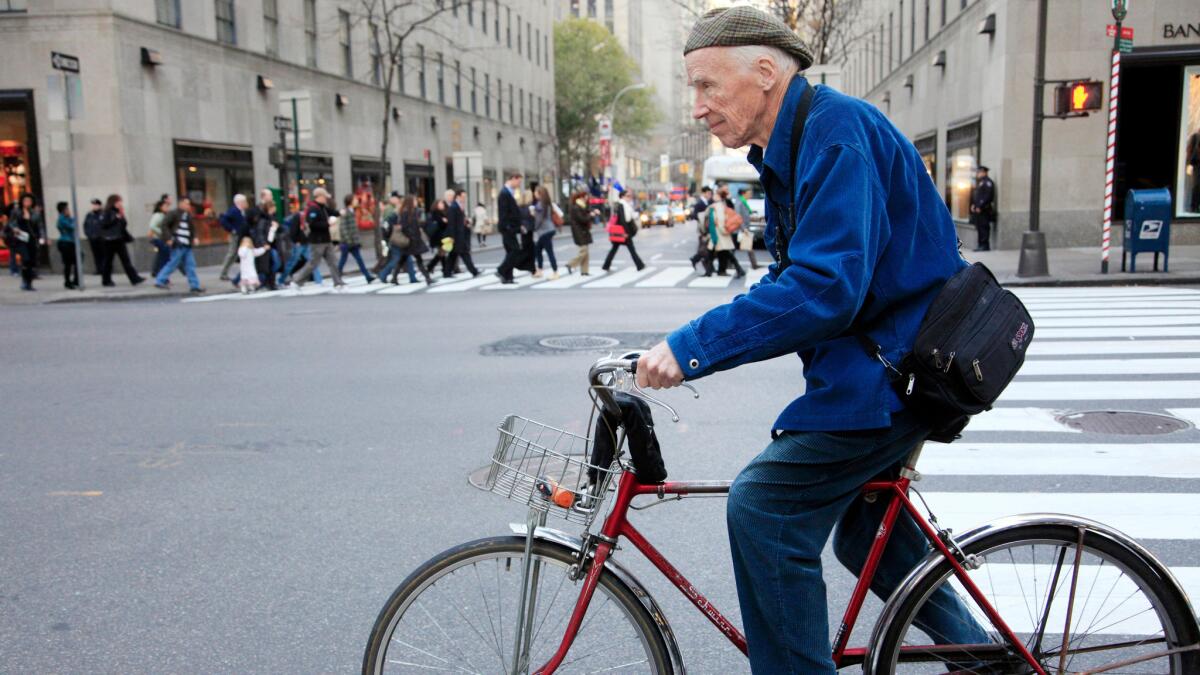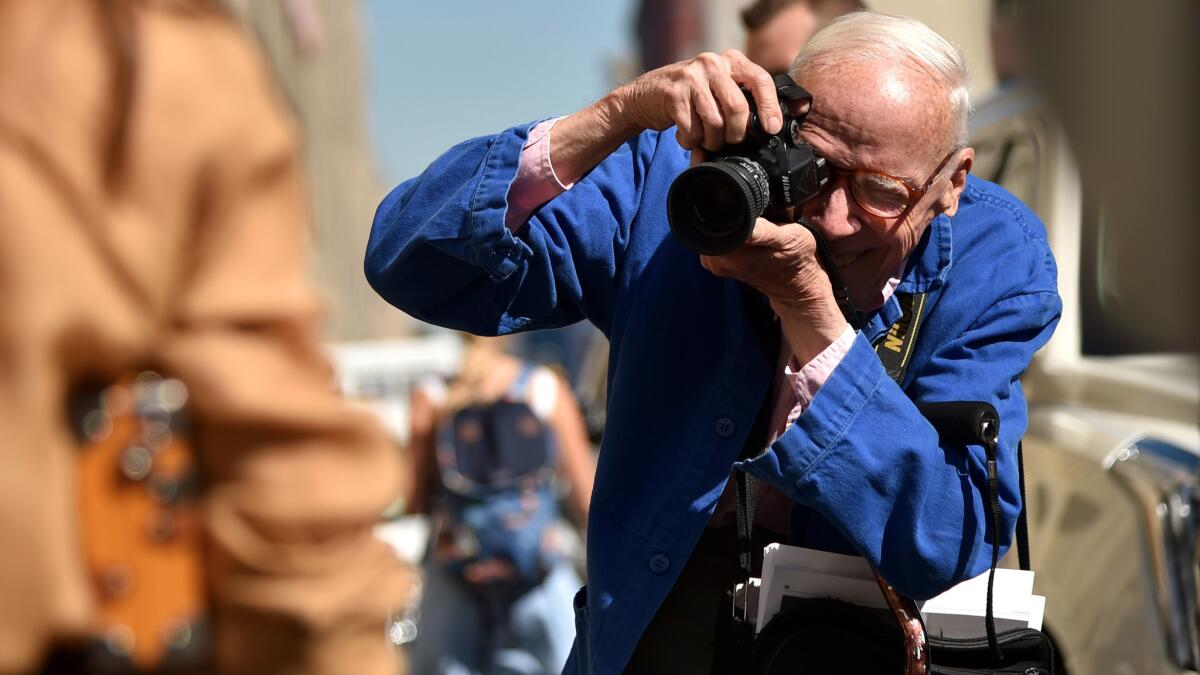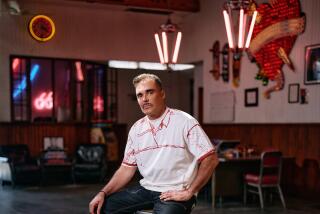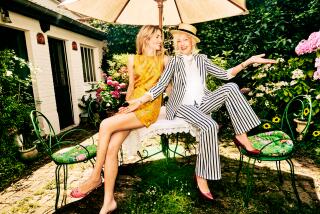Bill Cunningham dies at 87; iconic New York Times photographer who chronicled fashion high and low

- Share via
Bill Cunningham, the iconic New York Times fashion photographer who darted around New York City on a humble bicycle to cover the style of high society grand dames and downtown punks with equal verve, has passed away. He was 87.
Cunningham died Saturday in New York City, according to Eileen Murphy, a spokeswoman for the newspaper. He had been hospitalized recently after suffering a stroke.
“He was incredibly open-minded about fashion,” New York Times executive editor Dean Baquet said in a statement issued shortly after Cunningham’s death.
“To see a Bill Cunningham street spread was to see all of New York. Young people. Brown people. People who spent fortunes on fashion and people who just had a strut and knew how to put an outfit together out of what they had and what they found.”
“He was using his camera to document not just how people dress, but who we are,” filmmaker Richard Press, who directed the critically-acclaimed documentary “Bill Cunningham New York,” told the Los Angeles Times via telephone. “If you want to know what the last half of the 20th century looked like and felt like — the people who were the tastemakers, the people who were part of culture — you would turn to Bill Cunningham’s photographs.”
To see a Bill Cunningham street spread was to see all of New York.
— Dean Baquet, executive editor of The New York Times, in a tweet
Cunningham’s work became widely known in 1978, after he began publishing compendiums of street fashion for the New York Times. It was a chance photograph of Greta Garbo that got him the gig, drawing the attention of the paper’s editors.
Cunningham had caught the actress on the street in Manhattan, but had been more interested in her nutria coat than in her. “I thought: ‘Look at the cut of that shoulder. It’s so beautiful,’” he later wrote. He snapped away, only to realize later that he’d captured the Swedish-born actress.
His humility and his practically monastic devotion to fashion above all else carved for him a lasting spot in the here-today, gone-tomorrow business of fashion. Cunningham was always readily identifiable by his uniform, which consisted of a blue, French workman’s smock, a small camera bag, and his always trusted bicycle.
“When he came to openings or fashion shows, he would slip in and out without a fuss,” said Brooke Hodge, director of architecture and design at the Palm Springs Art Museum, who was once photographed by Cunningham wearing a Comme des Garçons coat. “He had a certain independence and was unique in the fashion world for that — although he would probably hate to be referred to as being in the fashion world.”
William John Cunningham Jr. was born in Boston on March 13, 1929, to an Irish Catholic family. From a young age, fashion was always on his mind. As a boy, he made his mother a hat to wear to the New York World’s Fair. As a teenager, he worked at the Bonwit Teller department store.
After dropping out of Harvard University in 1948, he moved to New York and worked as a hat maker, producing a line under the label “William J.” He left the “Cunningham” off, he later told the New Yorker, because “my family would have been too embarrassed.”
Joe Eula, an illustrator who was an acquaintance of Cunningham’s at the time, later recalled a so-called “bathing suit hat” that had fringe that went from the brim to to the ground, allowing the wearer to change clothes behind the fringe. “His hats were the grand opera of all time,” he told the New York Times in 2002.
He was using his camera to document not just how people dress, but who we are.
— Richard Press, director, “Bill Cunningham New York”
After a stint in the Army in the 1950s, Cunningham returned to New York, where he wrote fashion pieces for the Chicago Tribune, and later Women’s Wear Daily. In the late 1960s, he segued into photography and started taking photographs of people on the streets before joining the New York Times.
In a 2002 interview with the paper, Cunningham said he always tried to be as discreet as possible because “you get more natural pictures that way.”
“I suppose, in a funny way, I’m a record keeper. More than a collector,” he said. “I’m very aware of things not of value but of historical knowledge.”
Cunningham wasn’t just a style reporter. He was a cultural anthropologist. And he was dedicated to his work above all. For decades, he lived sparely in a tiny studio above Carnegie Hall, where he slept on a small cot amid his archives. And he maintained a rigorous schedule that included covering street fashion by day and society soirees by night — all with the aim of recording how the great gamut of society wore its clothes.
His street work, above all, is what captured the public imagination — and certainly served as the early precursor to street style websites like the Sartorialist. Cunningham would spend hours patrolling busy intersections to capture the emergence of a new trend, an avant-garde cut, or a midtown secretary making a style statement by donning a coat with four sleeves.
“I let the street speak to me; you have to stay on the street and let the street tell you,” Cunningham is seen saying in his documentary. “There are no shortcuts, believe me.”
“It was a great antidote to the well-choreographed commercial runway shows: to see what the real people on the streets were wearing,” said Sharon Takeda, who oversees the department of costume and textiles at the Los Angeles County Museum of Art. “The way he curated it so that you got what the trends were — he knew fashion well.”

Though modest, retiring and exceedingly ethical (Cunningham was known for returning or giving away any gifts sent to him at the paper), the photographer nonetheless set a toe in the limelight on a handful of occasions.
In 1993, he was honored by the Council of Fashion Designers of America and took the stage on a bicycle. And in 2010, he was the subject of the documentary “Bill Cunningham New York.”
Press, the director, says it took an overwhelming amount of cajoling to get Cunningham to cooperate. “The joke is that it took ten years to make the movie and eight of those to convince him to do it,” he said. “And even when he agreed, he didn’t really agree. He was always reluctant and we were always in negotiation ... But he slowly, over time, opened himself and his life up to us.”
Filming took a year, says Press, during which time the director and the cinematographer followed Cunningham around New York City on bicycles.
In 2014, the New-York Historical Society exhibited a series of photographs Cunningham took in the ‘60s and ‘70s that featured juxtapositions of architecture and fashion, whimsical photo essays that employed his long-time muse and fellow photographer, Editta Sherman.
The photographs had been previously compiled in the 1978 book “Facades.” Cunningham donated nearly all of the 88 gelatin silver prints from the series to the New-York Historical Society.
Cunningham has also been honored by the French Ministry of Culture (in 2008) and received the Carnegie Hall Medal of Excellence (2012).
Press says the photographer leaves a rich legacy.
“His complete body of work is going to be a significant document of our time,” he said. “Everybody who is important — culturally, politically, in fashion and the arts — went before his camera. And he documented a place: New York, the high and the low, all classes, all races. It’s a portrait that’s so complete.”
Just three weeks ago, Cunningham was still out on the town chronicling street fashion, filing a report about black and white ensembles for the paper on June 3.
To the end, his work was never caught up in nostalgia or harsh judgment.
“People say everybody’s a slob,” Cunningham told the New Yorker in 2009. “Ridiculous! There are marvelously dressed women you see at a quarter to eight, going to business. When people say fashion is no more, they’re ridiculous! It’s as good as it ever was.”
Associated Press writer Ula Ilnytzky contributed to this report.
Find me on Twitter @cmonstah
ALSO
Ruben Aguirre, who played ‘Profesor Jirafales’ in an iconic Spanish-language series, dies at 82
Thomas J. Perkins, Silicon Valley venture capitalist, dies at 84
Jim McMillian, former Laker on historic 1972 team, dies at 68
UPDATES:
7:31 p.m.: This article was updated with new details and staff reporting.
4:12 p.m.: This article was updated with new details throughout.
This article was originally published at 3:18 p.m.
More to Read
Start your day right
Sign up for Essential California for the L.A. Times biggest news, features and recommendations in your inbox six days a week.
You may occasionally receive promotional content from the Los Angeles Times.







